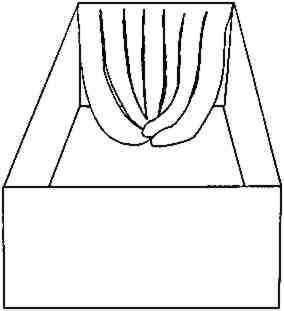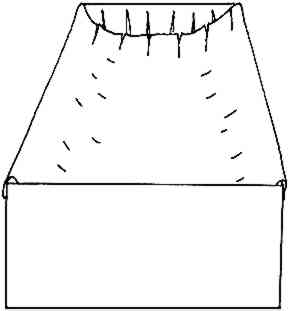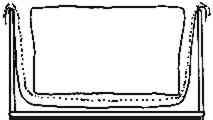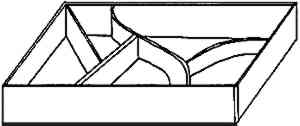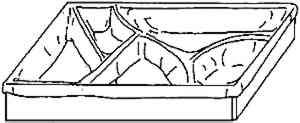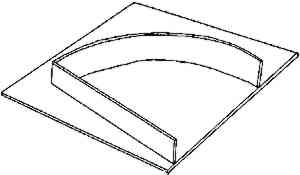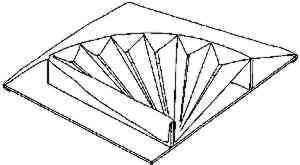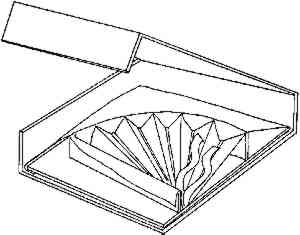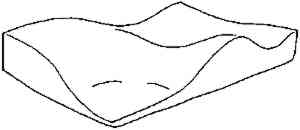PAPER-BASED SUPPORTSHUGH PHIBBS
ABSTRACT—Paper can be a very effective support material for housing objects. Historically, works of art and artifacts on paper have been stored in paper enclosures with great success. If housings are properly designed, paper can also be used to store small objects. Papers are available in a wide variety of weights, textures, and chemical compositions. They can be used with different adhesives to create inexpensive, conformal supports that can be tailored to the physical and chemical needs of the object. Designs are described here for scrolls, mixed collections, fans, and objects with fragile edges and irregular lower surfaces. TITRE—Les Supports en Papier. R�SUM�—Le papier peut servir de support tr�s efficace pour le stockage des objets d'art. Depuis longtemps, les oeuvres d'art sur papier ou les objets d'art en papier sont conserv�s avec beaucoup de succ�s dans des coffrets de papier. Si ces coffrets sont bien con�us, le papier peut aussi �tre utilis� pour de petits objets. Le papier existe dans une large vari�t� de poids, de textures et de compositions chimiques, et il peut �tre utilis� avec des adh�sifs diff�rents pour cr�er des supports peu co�teaux conformes aux normes et adapt�s aux besoins physiques et chimiques de chaque objet. Cet article d�crit les diff�rents types convenants � des rouleaux, � des collections mixtes, � des �ventails et � des objets aux bords fins ou fragiles et aux bords inf�rieurs irr�guliers. T�TULO—Soportes en base a papel. RESUMEN—El papel puede ser un soporte muy efectivo para alojar los objetos. Hist�ricamente, las obras de arte y los artefactos de papel han sido almacenados con mucho �xito en sistemas de almacenamiento de papel. Si los sistemas de almacenamiento son dise�ados apropiadamente, el papel tambi�n puede ser usado para objetos peque�os. Los papeles est�n disponibles en una amplia variedad de las pesos, texturas, y composiciones qu�micas y pueden ser utilizados con diferentes adhesivos para crear soportes econ�micos ajustables a la forma, los cuales pueden ser hechos a la medida de acuerdo a las necesidades f�sicas y qu�micas del objeto. Se describen dise�os para rollosos, colecciones diversas, abanicos, y objetos con los bordes fr�giles y superficies bajas irregulares. 1 INTRODUCTIONPaper can be used to create support structures to house a wide variety of works of art and artifacts. Albums, window mats, and folders have protected works of art on paper for many years. When proper designs and adhesives are employed, paper can be used to support solid or nonplanar works. The available range of weights, textures, and chemical compositions increases the utility of paper in the creation of housings that provide steady, inert, nonconstrictive support. Papers can be bonded with many different types of adhesives to accommodate the chemical requirements of the work. Conservation-quality papers are made of cotton and cotton linters, linen, abaca, alpha cellulose from purified wood pulp, and bark-derived fiber such as kozo, gampi, or mitzumata. These fibers differ in strength, absorbency, and texture, but in their lignin-free forms they provide a simple material that has been shown to be inert over long periods. Chemical buffers such as calcium carbonate enhance the longevity of a paper and An object that may contain highly reactive constituents such as proteins can be housed in an enclosure made of a simple lignin-free cellulose without an alkaline buffer. The components of the enclosure are joined with starch or an appropriate thermoplastic adhesive. Objects made of materials that may themselves off-gas, such as celluloid or wood laminates, could be housed in a structure made of paper or board that can scavenge those pollutants. When the object requires isolation from an unstable or deleterious environment, a barrier layer such as a plastic and metal foil laminate or plastic impregnated with a metallic sacrificial scavenger can be placed outside the primary support structure. The barrier may be used or not, as conditions dictate. 2 INSTRUCTIONS FOR SPECIFIC DESIGNSThe designs to be considered here are slings, paper-lined cells, cut and folded paper supports for fans, and contoured bases to fit objects with irregular undersides. The sling is the simplest of these support structures to build, and it will take the shape of a rounded or columnar object. The sling begins with a box made of an appropriate material such as lignin-free corrugated board, which has been designed so that its interior dimensions exceed those of the object to be housed. Many objects, such as scrolls, may have delicate materials at their ends, which should not be allowed to bump against the ends of the box. A set of paper strips at either end of the box can serve as cushions. Create each strip from a sheet of paper that has parallel cuts made perpendicular to one side and the uncut side bonded to the outside upper edge of the end of the box. Gather the cut strips and bond them to the center of the box bottom (fig. 1). The sling should be slightly longer than the box, and it should have cuts made in each end, which will meet the cushion strips. Bond the sling to the outside upper edges of the box sides so that its lowest portion hovers above the bottom of the box and its cut ends curve up along the cushion strips (fig. 2). This housing will give maximum distribution to the weight of the object in the sling and will prevent damage to the ends of the
When objects with differing shapes are to be housed together, a tray with individualized cells can support and stabilize them. This tray begins with the objects to be housed laid on a support board so their positions can be traced in graphite with a mechanical pencil. Then bond strips of conservation-quality board to the support board along these
Folding fans are particularly challenging to house. Storing the fan in the open position avoids exercising its joints but yields a complicated and delicate shape to be supported. A tray covered with paper folded to fit the back of the fan can be made with surprisingly little time and effort. Cut a support board to a size larger than the open fan, and draw an outline of the fan on the board with a mechanical pencil roughly one inch from the fan's edges (fig. 6). Cut strips of conservation-quality board and attach them to the support board along these lines (fig. 7). Secure a sheet of paper to the back edges of the support board closest to the curved wall, and draw it over that wall. Attach the paper to the bottom of the V-shaped wall where it meets the support board and in a line across that wall that ascends toward the arc wall. Finally, fold the paper over the V-shaped wall and secure it to the outside of the wall. Once the adhesive has cooled or dried, lay the fan into the paper-covered cell. With a mechanical pencil, mark the points at which its low or “valley” folds meet the paper of the cell with a mechanical pencil. Then make cuts that radiate out from the center of the cell to the points marked at the curved outer edge. Gently fold the paper between these cuts between the thumb and forefinger so that “mountain” folds are created between the cuts corresponding to the location of the “mountain” folds in the fan. To secure the fan, attach a lashing of cotton twill or twisted paper to the bottom of the support at the point at which the vanes of the fan intersect (fig. 8). Add a lid made of rigid board to protect the fan from light, dust, and injury.
An object that has an irregular underside and delicate edges can best be stabilized in a housing that is contoured to fit the shape of the underside. The creation of this conformal support structure begins with the placement of the object on a large, soft sheet of paper resting on a support board that is larger than the object. Temporarily support the parts of the back of the object that do not touch the paper surface with blocks of polyethylene foam placed between the paper and the support board. Tear pieces of progressively thicker material—first paper, then two-ply board, and finally four-ply board—and shape them to fit the cavities in the underside of the object. Tack these layers in place to the surface of the support board (fig. 9). Trim V-shaped ribs of folded four-ply board so that they will fit in the space between the back of the lamination and the support board. These ribs may have to be tested in various positions before a proper fit is found. Then fold the soft paper under the object around the sides of the support and secure it to the support bottom. The resulting structure may resemble a model landscape when the object to be housed is removed (fig. 10). The weight of the object in combination with the
3 CONCLUSIONSModern polymers in sheets and foams can, of course, be used to create many useful support structures. It may be difficult to choose materials that are chemically inert and physically accommodating for long periods, carve them, and adhere them. Paper, which is easy to form and comes in numerous varieties, can be an inexpensive alternative. It accepts a wide range of adhesives and adapts to diverse designs and combinations of materials, accommodating the needs of many objects. Paper is one of the oldest storage materials and still one of the best. AUTHOR INFORMATIONHUGH PHIBBS is the coordinator of graphics conservation services in the Department of Exhibitions and Loans, Conservation Division, National Gallery of Art, Washington, D.C. He has a B.A. in philosophy from Cornell University, and an M.F.A. in painting from the University of Michigan. He has taught workshops for AIC, the conservation programs at Winterthur/University of Delaware and the State University of New York at Buffalo, the Smithsonian Resident Associates Program, and programs of the Professional Picture Framer's Association. He was co-compiler of the matting and framing section of the Book and Paper Group Outline and has written four preservation supplements and a monthly column, “Preservation Practices,” for Picture Framing Magazine. Address: National Gallery of Art, 6th St. and Constitution Ave., NW, Washington, D.C. 20565.
 Section Index Section Index |
